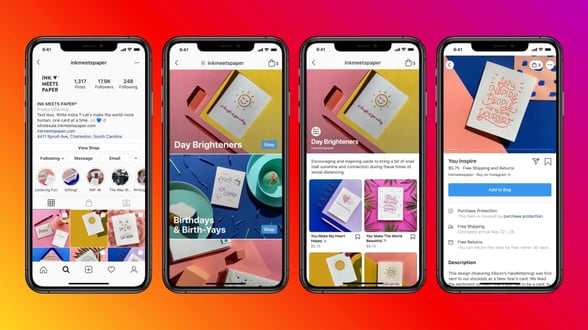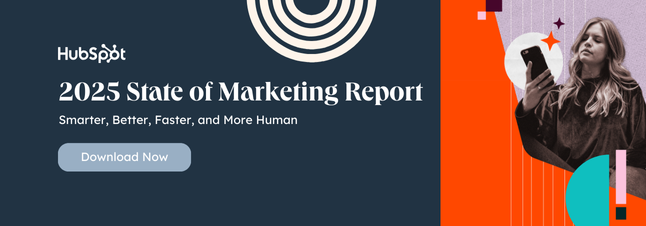It’s 2024, and the highest-ROI marketing channel is still good ol’ social media.
Our State of Marketing & Trends Report shows that 43% of marketers use it as a marketing channel. I wonder why that number isn’t even higher.
These days, sharing content on social media is a no-brainer for brands. Whether you’re looking for a strategy refresh or trying out the channel for the first time, this post is your guide to the different types of social media content, what works best, and how it can empower your business.
Different Types of Social Media Content
1. Video (Short-form, Specifically)
Social media marketers are still placing their bet on short-form videos in 2024, some even upping the ante:
- 67% plan to increase their investment in short-form videos
- 31% will maintain their current investment
- 33% plan to invest more in short-form videos than any other content form
It’s not surprising, considering short videos yield the highest ROI for social media marketing, according to HubSpot’s 2024 Social Media Trends Report.
Some common examples of short-form videos are TikTok videos, Instagram Reels, and YouTube shorts. This TikTok below is from Candeeze, a small husband-and-wife brand that sells freeze-dried candy online. It racked up 1.8 million views by showing the behind-the-scenes of their business operation.
Don’t forget live video — they gained steam during the pandemic allowing remote participation in events. Twitch and other popular live-streaming platforms let people interact with their favorite creators in real time. This format has the second highest ROI of all social media content types, according to 57% of marketers.
Long-form videos are also popular, despite having lower ROI than short-form. They’re more costly to produce; consumers expect high production quality from them while lacking the attention span to finish them.
But if long videos are your jam, don’t worry — for each long-form video you produce, you can repurpose it into multiple shorts, maximizing the value of your resources.
2. Audio Chat and Live Rooms
Remember when Clubhouse was all everyone could talk about? That frenzy has passed, but audio chats and live rooms are here to stay. Many platforms have native audio features, like Twitter Spaces, LinkedIn Live, and Facebook Live Audio.
Audio chat rooms let brands directly communicate with audiences and develop closer relationships than seeing a billboard or watching a YouTube video. And, during a time when customers value connections with brands more than ever, audio chat rooms are a valuable tool.
After seeing satisfactory ROI, 91% of social media marketers plan to continue or increase their investment in audio chat and live rooms.
Audio chat rooms are also trendy among Gen Z, the biggest social media demographic. A Spotify study found that 80% of Gen Z enjoy audio content because it allows them to express their individuality and explore different sides of their personalities.
3. Content That Represents Brand Values
Almost half of marketers say that content reflecting brand values is part of their existing social media strategy.
This type of content is anything that highlights what your company stands for, such as commitments to sustainable production practices, fair treatment of employees, social justice, and more.
Consumers care more than ever about what the brands they buy from stand for and the values they have. They want to know the causes that businesses support and the commitments made to bettering the world.
If you need an example of doing brand value content right, look no further than Patagonia.
It’s not just about loyalty: Marketers also say that it has the 5th biggest ROI of any trend. 48% of marketers are already posting this type of social media content.
4. User-generated Content
User-generated content (UGC) is content your audience creates that features your business/brand that is not paid for by your business. For example, someone shares a non-sponsored TikTok about how much they like your product or posts a picture wearing your clothing and tags your business.
This type of content is great to share on social media because it helps your audiences see that people use and like your products, vouching for you in a real-life way. Why toot your own horn if you can get someone else to do it, right?
UGC pays off, as customers trust reviews from friends and family more than they trust branded ads, and nearly 80% of people say UGC highly impacts their purchase decisions, considerably more so than branded content and influencer content.
When you do use UGC, the platforms it performs best on are YouTube (26%), Instagram (24%), and Facebook (21%).
5. Funny, Trendy, and Relatable Content
Social media marketers know the value of a viral post too well. They’re hard to come by, but you can increase your chance by hopping on viral memes, relating them to your business, and using trending hashtags or sounds.
This type of buzzy content requires a high level of awareness of what’s happening online, cultural moments, and current events.
Over 40% of marketers already share funny, trendy, and relatable content on social media, and 59% say they will double down on funny content in 2024, it being the most effective of the three. Consumers love it, too – they’re starved for quality humor from brands.
Our very own social media team is savvy at this kind of content, like this funny and relatable tweet.
6. Shoppable Content
Shoppable social media content allows consumers to browse through products on your accounts, discover things they like, and even make a purchase without leaving the app.
The image below is an Instagram storefront for Ink Meets Paper, where someone can browse its products, find what interests them, and make a purchase.

This is a valuable content type as social shopping is currently on the rise, and consumers are discovering new products and buying products on social media apps more than ever before.
In fact, social media is the most popular way for Gen Z, Millennials, and Gen X to discover new products — over 1 in 5 have made an in-app purchase in the past three months. No wonder 87% of marketers plan to maintain or increase their investment in social selling enablement tools in 2024.
The most effective platforms for selling in-app are Instagram (26%) and Facebook (26%).
7. Educational Content
Educational content shares helpful information with audiences that helps them reach their goals and meet their needs. It can come in infographics, videos, text-based posts, images — any of the content types we discussed in this post.
HubSpot often shares educational content through YouTube videos, where viewers can learn more about concepts of interest. The video below is a recent one that educates viewers on creating a brand style guide.
8. Ephemeral/Disappearing Content
Ephemeral/disappearing content is content that only stays up for a certain amount of time, like Instagram Stories that disappear after 24 hours.
Leveraging people’s FOMO is one of the oldest tricks in the marketing playbook. The feeling gets even more amplified in social media, which is why 47% of brands plan to increase their investment in this kind of “limited-time” content.
Users only have a set period to engage with it, so they might be more eager to keep track of your profiles and keep returning to experience.
Creating quizzes and polls in your Stories is a great way to leverage this type of content. People only have a certain amount of time to respond, generating excitement and immediate action and inspiring respondents to come back and see results.
Check out examples from LEGO, Harvard Business Review, and Outback Steakhouse, and see how they’re crushing it at the Instagram Stories game.
9. Other Types of Content You’re Familiar With
Images
Our recent survey found that 47% of marketers leverage images as a media format, which works well on all social media platforms.
Actually, 54% of marketers think that social media content that’s polished and has high production value (e.g. high resolution images/videos) is even more important than the content being authentic and relatable. But try to aim for both!
Text-based
We see text-based content on social media everyday, from Twitter(X) threads to thought leadership posts on LinkedIn. The primary goal is to share insight through words — you can pair it with an eye-catching image, but the point of the post is in the text.
Blogs are popular text-based content where people read longer posts and discover helpful information. But a common mistake is sharing blog links directly on social media. Social platform algorithms don’t favor linking out (they want you to stay!), so you better adapt an existing blog post into snackable takeaways that’s more suitable for social users’ habits.
Infographics
Infographics are a content type with the share-ability and visual appeal of photos but are filled with helpful data and information. It’s an impactful form of social media content and educational content.
The image below is a post from HubSpot’s Instagram account that is an infographic that informs viewers about the most effective traits of a sales leader.

Infographics are effective, too, with 51% of marketers that regularly use them saying it yields high ROI.
Repurposing Content Is Still A Valuable Strategy
Social media marketers say they use an average of three platforms in 2024, each with its best practices and norms to follow.
It can be challenging to create individual pieces of content for every single platform, so many marketers share similar content across platforms but repurpose it to fit the tone and requirements of each one.
The key to success, however, is repurposing content, not resharing. People don’t look fondly at brands that share the exact same thing on each platform. 47% of marketers already share similar content across platforms with tweaks to make it more relevant to the platform’s demands.
It’s a new era for social media. To keep up, I recommend you check out this video about creating a social media strategy this year and beyond.
Want More Social Media Insights?
Learn more about the State of Social media with more of this data, videos, and exclusive industry tips on our State of Social Media Hub— which will come with a free downloadable resource.


Recent Comments